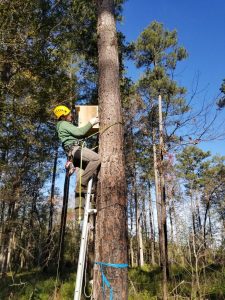I like to refer to the southeastern fox squirrel as the “eastern tree elk.” For people who have never seen one, their first experience with the east’s largest squirrel subspecies can be exhilarating. There’s just something about them that can’t be defined.
There are four subspecies of fox squirrel that inhabit Virginia. Over in the very farthest tip of southwest Virginia, there are a few of what are referred to as the mid-western subspecies of fox squirrel (Sciurus niger rufiventer), and they are very common in the mid-west. Moving a bit further east into the Ridge and Valley region of Virginia is our most common subspecies, known as the mountain fox squirrel (Sciurus niger vulpinus) to many. While well known in the mountains, this subspecies is moving further east. It is now quite common along the east slope of the Blue Ridge and is becoming more common in the western piedmont, with occurrences in central Virginia also increasing.

Traveling up to the eastern shore, you can find the Delmarva (Delaware, Maryland, Virginia) subspecies (Sciurus niger cinereus). While still very rare and on the state list of threatened species, due to successful reintroduction efforts the U.S. Fish and Wildlife Service recently removed the Delmarva fox squirrel from the endangered species list. And back to my primary topic the southeastern fox squirrel (Sciurus niger niger), the last of the four subspecies occurs in the southeastern region of Virginia, and becomes more numerous in North Carolina’s coastal plan and further south through South Carolina, Georgia and into Florida. While locally abundant in some states, this subspecies is considered to be in decline, largely due to habitat loss. They only occur in Virginia in pockets where suitable habitat exists in enough quantity to support long-term populations, mostly in the counties east of I-95 and south of I-64 – our southeastern coastal plain.
Fox squirrels are perhaps the most variably colored mammals in North America. They occur in colors from oranges, to reds, to whites, blacks and all mixes of the above. They are about twice the size of the average gray squirrel. It is believed that the southeastern fox squirrel used to occur up into south central Virginia in counties like Nottoway, Amelia, Lunenburg, Dinwiddie, Brunswick and Mecklenburg. The southeastern subspecies tends to have more black coloration than other subspecies, often having a black belly and a lot of black on its face, but with white ears and nose markings. Very little is known about this squirrel in Virginia, however substantial studies have been conducted in North Carolina and further south. We are currently working in cooperation with multiple partners on a southeastern fox squirrel study in Virginia. There are two study sites, one consists of The Nature Conservancy’s Piney Grove Preserve combined with DGIF’s Big Woods Wildlife Management Area over in Sussex County. A long-term population of southeastern fox squirrels occurs on these areas, though we do not know how numerous they are. In an effort to better understand them, we erected 75 fox squirrel nesting boxes (15 at 5 sites) on these areas. Our hope is that we will be able to capture and place radio-telemetry collars on at least a few to gain a better understanding of how they use the habitat. The southeastern fox squirrel is known further south as a denizen of the open long-leaf “piney woods” (especially where prescribed fire is used routinely), but here in Virginia they have adapted to a mixture of mature, open loblolly pines, adjacent to hardwood drainages.
Our second study site is on Ft. Pickett Army Maneuver Training Center in south central Virginia. Ft. Pickett Environmental Program Funds are our primary funding source for the entire project. The research is being conducted in partnership with Virginia Tech and the Conservation Management Institute. At Ft. Pickett we also erected 75 fox squirrel nesting boxes. We do not know if any fox squirrels exist on Ft. Pickett, but we hope if they do we can document them via the nesting boxes and trail camera usage. Phase 2 of this project might also include some trapping and translocation of southeastern fox squirrels from North Carolina to Ft. Pickett. We continue to develop the project and work out the details.
What is interesting about southeastern fox squirrels is that their habitats are highly compatible with bobwhite quail, and also the endangered Red-cockaded Woodpecker, which is an important consideration of management at Piney Grove and Big Woods in Sussex County. All these species are adapted to open canopy pine forests where fire is frequently applied.
The Piney Grove – Big Woods complex (which includes Big Woods State Forest) also serves as Virginia‘s primary National Bobwhite Conservation Initiative Coordinated Implementation Quail Focal Area. This makes it part of the nation’s largest ever coordinated bobwhite quail study. I’ll also mention that deer, turkey and many other species benefit greatly from the management being done to help an endangered species. Add to this our recent partnership with the National Wild Turkey Federation on Big Woods WMA and State Forest, and I hope you can see the value of partnerships in ecosystem management. Our team at Big Woods was awarded a Superfund Project Grant from NWTF this spring that is allowing us to revamp multiple logging decks, turning them into brood fields for turkey poults and quail chicks, and also creating good pollinator habitat. Over time some of the native plant species we will use to re-seed the logging decks will spread into the surrounding areas increasing the native plant diversity.
And at Ft. Pickett, even though military training takes precedence over habitat management, wildlife and habitat are a top priority. The quality of the deer, turkey, squirrel and quail hunting found there is hard to beat. Their long-term use of prescribed fire as a management tool, combined with fires that result from military live fire training within impact zones, creates some of the most unique habitats in Virginia.
Both of these areas, the Piney Grove – Big Woods Complex and Ft. Pickett have several things in common. They are relatively large, contiguous blocks of habitat (10,000 acres and over 40, 000 acres, respectively), they actively manage timber with an emphasis on creating wildlife habitat, they routinely use prescribed fire, they welcome partnerships, and they are practicing ecosystem management, not single species management. These are just two examples of where synergy and partnership converge in Virginia and throughout the nation to benefit multiple public user groups. Whether you hunt, fish, hike, camp or watch wildlife, or “all the above,” wildlife benefits most when we work together to actively manage the contiguous blocks of public lands over which we have been given stewardship.







